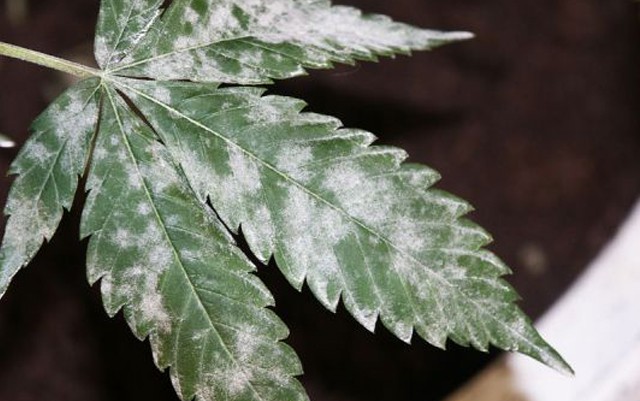The large scale indoor Cannabis farming facilities popping up in Colorado’s industrial parks provide clean room grade conditions for the cultivation of Medical Marijuana. Strict quarantine of incoming materials, sterile growing media, plus HEPA filtered air with computer monitored temperature and humidity ensure investors and patients that their valuable crops remain free of infectious pathogens. During the vegetative growth phase, some indoor cultivators burn sulfur as a preventative measure against fungal diseases such as Powdery Mildew. Great care must be taken to avoid breathing the resultant hazardous fumes and to prevent accidental fires.
The coal mine canary of my backyard garden is Zucchini. Summer Squash seem especially vulnerable to Powdery Mildew infections. I start treating my Tomatoes with Serenade as soon as I see Zuke leaves coated white.
Home Cannabis gardeners can attempt to replicate indoor professional methods by purchasing horticultural tents which house the grow under controlled lighting, humidity and temperature while isolating, filtering and venting telltale terpene fragrances away from “nosy” neighbors. Short of building your own clean room, practice a few simple common sense rules to reduce the chances of ruining your Cannabis by introducing pathogens.
- PETS! Keep Fido and Fluffy out of your grow room. The snuggly fur of our beloved companion animals is the perfect hiding spot for infectious spores.
- Sterilize your tools. To prevent spreading pathogens and disease from one plant to another, dip tools such as pruners into a dilute bleach solution, or spray with an off the shelf product like Lysol before and after each use.
- Take off your shoes, or step though a tray of disinfectant solution before entering your grow room.
Chances are, you won’t notice your plants have Powdery Mildew until the final stage of the infection, when the organism builds up spores for reproduction. Developing spores form the telltale white powdery substance coating the leaves. As with Gray Mold, Tomatoes suffer similar damage. ( http://www.ipm.ucdavis.edu/PMG/r783100411.html )
Powdery Mildew requires acidic conditions. One effective home preventative remedy is to regularly spray leaves with a dilute mix of milk (fungicidal) and baking soda (high pH) to create an alkaline environment on the leaf surface which discourages the pathogen from taking hold.
Keep your plants well spaced and prune away lower leaves to improve airflow. If Powdery Mildew spores are present on the leaves great care must be taken not to disperse the encrustation while removing and disposing of plant material.
Infected leaves and flower buds are not appropriate for consumption. Ed Rosenthal, on page 409 of his Marijuana Grower’s Handbook, suggests that you can recover your losses by using the bad buds “. . . to make water hash. Because the hash-making process washes molds from the glands. . .”
Disclaimer: Any advice and opinions offered about the cultivation of cannabis by Bruce N. Goren are his own and do not represent the University of California or the Master Gardener Program.






